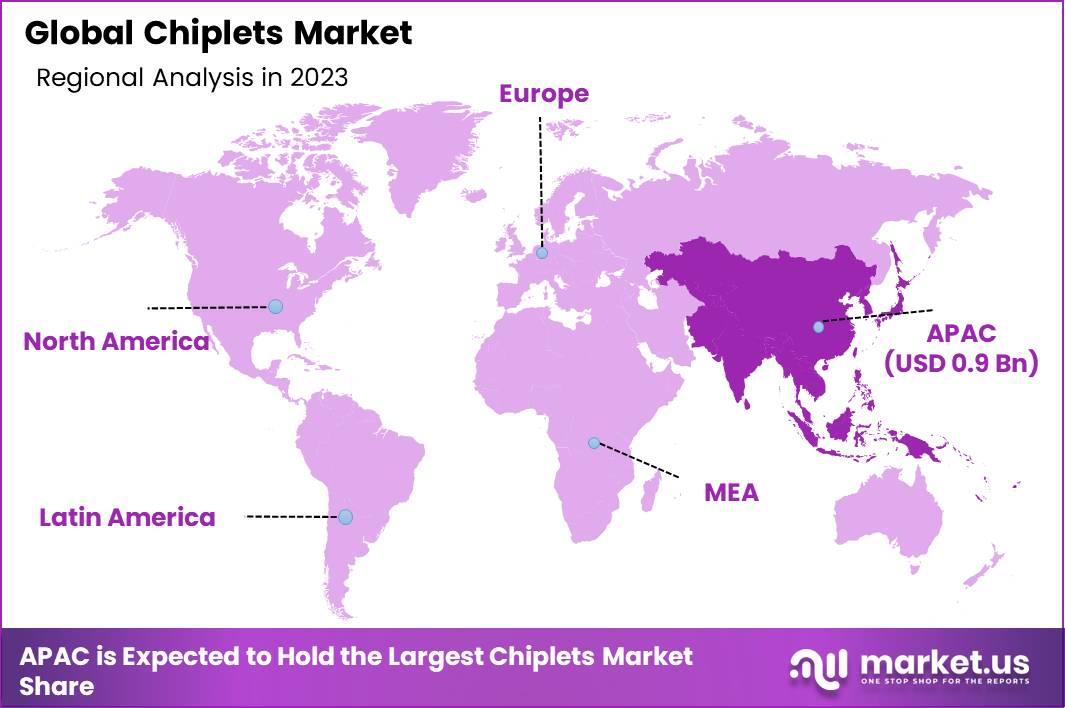"Chiplets Market: An In-depth Study of Competitive Landscape"

The chiplets market is on the cusp of significant expansion, fueled by a myriad of factors that highlight its critical role within the semiconductor sector. This expansion is driven by the escalating demand for high-performance computing across various domains, including artificial intelligence (AI), machine learning (ML), data analytics, and cloud computing. Chiplets, with their modular design, offer a scalable and flexible solution to meet these needs, presenting a cost-effective alternative to traditional monolithic chip architectures. The advancements in packaging technologies, such as 2.5D and 3D integration, further facilitate the assembly of chiplets into cohesive units, propelling their adoption.
According to Market.us, The global chiplets market is expected to surge at a CAGR of 42.5%, reaching USD 107.0 billion by 2033, with a valuation of USD 4.4 billion in 2024.

However, the path to growth is strewn with challenges. Ensuring seamless integration and interoperability among chiplets from different vendors remains a daunting task, necessitating standardization in interfaces and protocols. The increased performance density brought about by chiplets also introduces complex thermal management issues, demanding innovative cooling solutions to maintain system reliability. Moreover, the modular nature of chiplets complicates testing and validation processes, while the dependency on a diverse vendor ecosystem adds layers of complexity to supply chain management.
Despite these challenges, the chiplets market is ripe with opportunities. The chiplet model encourages the development of a collaborative ecosystem, allowing companies to specialize in different chiplet types and fostering innovation. This opens up possibilities for tailoring semiconductor solutions to niche markets, expanding the industry's reach. The necessity for efficient chiplet communication is driving advancements in interconnect technologies, offering prospects for breakthroughs in optical interconnects and high-speed data transfer protocols. Furthermore, chiplets hold the promise of enhancing sustainability within the semiconductor industry by enabling the reuse of existing designs and reducing the environmental footprint of new chip production.
Top Key Players
- Intel Corporation
- Advanced Micro Devices Inc. (AMD)
- Taiwan Semiconductor Manufacturing Company Limited (TSMC)
- NVIDIA Corporation
- Samsung Electronics Co. Ltd.
- GLOBALFOUNDRIES
- Xilinx Inc.
- Micron Technology Inc.
- Broadcom Inc.
- Qualcomm Incorporated
- Toshiba Corporation
- ON Semiconductor
- Other Key Players
Market News
In 2023, Intel Launched Ponte Vecchio GPUs: These chiplet-based GPUs boast an impressive HBM3 memory architecture and are designed for high-performance computing (HPC) applications.
In 2023, NVIDIA Introduced Grace CPU: This chiplet-based CPU marks NVIDIA’s foray into the server market, promising exceptional performance and scalability for data centers.
In essence, the trajectory of the chiplets market is marked by a balance of growth factors, challenges, and opportunities. The demand for advanced computing capabilities, combined with the strategic advantages of chiplets in scalability, flexibility, and cost-efficiency, sets the stage for widespread adoption. Simultaneously, the industry is called upon to navigate integration, thermal management, testing, and supply chain hurdles. Yet, these challenges also pave the way for innovation and market development, underscoring the chiplets model's potential to redefine semiconductor manufacturing and design, and herald a new era of collaboration, customization, and sustainability in the sector.
- Chiplet_market
- Semiconductor_Technology
- Chiplet_market_Share
- Chiplet_market_Size
- Chiplet_market_Trends
- Chip_Design
- Advanced_Packaging
- Modular_Electronics
- Scalable_Integrated_Circuits
- Semiconductor_Industry
- Microelectronics
- Electronic_Components
- System-on-Chip_(SoC)
- Chiplet_Integration
- Semiconductor_Manufacturing
- Semiconductor_Trends
- Semiconductor_Innovations
- Electronic_Devices
- Chiplet_Ecosystem
- Interconnect_Technologies
- Semiconductor_Fabrication
- Semiconductor_Engineering
- Chiplet_Solutions
- Semiconductor_Market
- Art
- Causes
- Crafts
- Dance
- Drinks
- Film
- Fitness
- Food
- Games
- Gardening
- Health
- Home
- Literature
- Music
- Networking
- Other
- Party
- Religion
- Shopping
- Sports
- Theater
- Wellness
- IT, Cloud, Software and Technology


